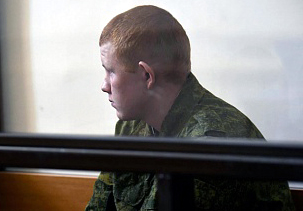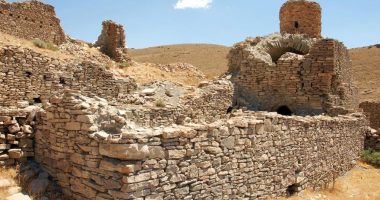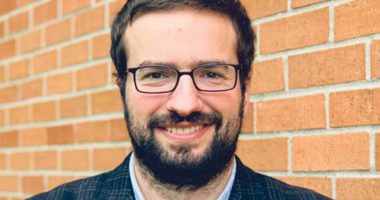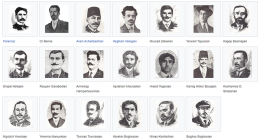Following is an Introduction to a new book by Seta B. Dadoyan titled “2015 The Armenian Condition in Hindsight and Foresight – A Discourse”
Introduction
The Armenian Condition in Critical Perspective
2015, the Centenary of the Genocide in 1915, marks the end of an era. As we stand at the threshold of a new one, we realize that between a partially known past and an imagined future the present is only an interval but of existential dimensions. The next Armenian century is a metaphor for the fate of the Armenians, because both anticipated and feared, it involves their spatial-temporal totality, or the Armenian Metasystem.
Addressed primarily to the wider public as well as intellectuals, in method and objectives, this is a critique, or an assessment of the Armenian condition, and generally things Armenian in hindsight and foresight. Hindsight means retrospection and analysis of the significance of past events after their occurence. It does not always mean perfect vision, but it is absolutely essential to figure out what caused these events, what should have been done, and the lessons to be learned. Foresight is the insight gained to look into the future on the basis of an understanding of the past and present. With an intention and courage to improve the situation, it is also the ability to predict the course of events before their occurrence. In all cases, a critical disposition is both a requirement and a key.
As opposed to traditional methods, and combining rather than separating the poles of philosophy and social sciences, also taking the 2015 as a starting point, this study is explanatory, interdisciplinary, practical, and normative. The project will be truly critical to the extent that it contributes to the liberation/emancipation from ideological rationalizations, sedimentations, and routine practices on all the levels of Armenian culture. By increasing the chances of conscious freedom of thought and action, this is also an attempt to open a new space, away from stagnation, domination and manipulation in whatever form they appear and operate.
At this junction in Armenian history, the critical approach seems to be an imperative, because the dominant traditional ways past and present have proved to be too limited and conservative. Furthermore, they have falsely naturalized contingent social-cultural realities and obscured the relationship between these realities and the public. As a consequence, the status quo has been seen as a reflection of some ‘natural’, inevitable and immutable ‘Armenian order’ to which individuals and communities must adapt and conform. New insights and knowledge will hopefully translate into a comprehensive critique and provide normative bases for inquiry into things Armenian in general. Since, as H.-G. Gadamer (1900-1902) suggests, the practical application of knowledge is inherent in the very understanding of something, and what one understands makes a difference in what one does, the critical approach should also provide grounds for alternative practicable ways of possible reconstruction.
Similar to most recent and contemporary thinkers, I consider thinking/understanding a social-historical form of activity. All phenomena are socially pre-formed through the historical character of the perceiving/performing subjects and the objects of knowledge. Both are shaped by human activity under specific temporal-spatial circumstances. Consequently, all concepts express social structures within which they are found. In turn, systems of thought are the result of turns of history, and not emanations from extra-historical realities.
The next point at which this study radically differs from most others in the literature of Armenian humanities and social sciences,concerns the ‘situatedness’ of individuals and communities. Like all human beings, Armenians are thrown, as it were, into a history, or a set of stories that they did not start and cannot finish, but which they must continue in one way or another. The Centenary is an occasion to reflect not only upon a major cataclysm, but a vast amount of historical and cultural traditions, narratives, ideologies, projections, also “prejudices” (in Gadamer’s words) or pre-judgments. In order to determine how to act, they must first understand themselves with respect to the stories in which they find themselves, as to who they are and where/how they want to go.
The peculiarity of the situation is that while people are already in the process of going on as Armenians, they should also decipher the stories of which they are a part. To this extent, Armenians’ understanding of their history starts at the middle of an ongoing narrative. They have to continue to live and act while they are in the process of trying to understand/explain both themselves and their national narratives. The situation is more complicated than it appears, because for many the understanding of the meaning of their peculiar history and traditions is simply inherited and re-projected into the process of understanding. In sum, standing in a constantly changing temporal/spatial position, the texts that Armenians need to understand, in one way or another, are part of the narratives in which they already find themselves. This is what existentialists call situatedeness. It means that consciousness is historically-effected and that people are embedded in their particular history and culture which shaped them anyway. Thus, Armenians do not come to any given episode or subject without certain forms of pre-judgment and pre-understanding and, which may be both positive and negative, as far as the facticity or the factuality of the information is concerned. This study stops at length at the conditions for more subtle interpretations of the Armenian past and depictions of future possibilities.
Understanding history is a way of attending to things and reacting to them directly. Even though knowledge is always finite and never complete and certain, to understand, as Gadamer explains, means to grasp, to agree, to be able to do/act, and be fully and actively part of the historical processes. The historicity of both the knower and her/his understanding has the force of an axiom, at least for this study. Granting the importance of historical situatedness and the applied character of any understanding, what one understands makes a difference in what one does, and what matters is what happens to people once they find themselves in this hermeneutic circle.
Temporality distinguishes this hermeneutic experience. This is its three dimensional character (past, present, and future). It means that the present moment or the Centenary, includes both the past and the future,and that these three dimensions are mutually reciprocal and inter-affective. For Armenians the object of the understanding process at this junction is not the capturing of immutable truths of the past and epic dreams for the future, but rather in the absence of traditionally assumed a priori ahistorical bases, providing fresh interpretations of Armenian realities. At least theoretically, everyone is supposed to be involved in a historical living/learning process, in which the knower and the known object are part of the same circle of analysis. No one and no institution is or should claim to be a disembodied knowledge-machine /source.
As it will soon become manifest, this study gives great importance to historical knowledge, and knowledge in general. Because knowledge is strictly embedded in serving human interests, in this case the interest of the Armenians. It follows that it cannot be considered value-neutral and/or objectively independent. Armenians do have an interest in knowing their history in dynamic and contemporary terms, because such interest is attached to the preservation of their identity and persistence. To preserve their identity means to see their fundamental interest in the emancipatory force of understanding and knowledge. In view of the relation of knowledge to power, and as far as Armenian identity is concerned, emancipation seems to be an appropriate path to the subject. T. Adorno’s (1903-1969) theory of what he calls ‘culture industry’, ‘cultural commodities’ and ‘mass entertainment’ is a most useful analytical tool for this study. The theory opens new perspectives to look into society. Both intellectual and mass cultures – including and specially mass media – are binding elements in modern societies.
Viewed in this manner, the Armenian culture industry in turn constitutes a principal source of power and hence, its authority and domination. Contemporary culture is indeed a condition identical to all other forms of production. It has its capitals, producers, consumers, goods, markets, and above all channels and media networks. Modern society is mass consumer society with respect to culture as well, and in particular. The arts and entertainment are the very areas of life within which people are vulnerable because they believe that they are genuinely free from all pressures. But in fact the arts, entertainment and constant exposure to the media perpetuate domination by overwhelming and pacifying the people, thus obstructing the development of genuinely free critical attitudes. Despite the manifest diversity of cultural commodities, the culture industry is a uniform and global system, to which the consumer as well as the producers conform. The goal is the production of ‘cultural goods’ that are consumable and profitable, including the political interests of the various ‘producers’. Indeed modern politics is largely part of contemporary culture and entertainment too. The assorted media of the culture industry constitute a veritable web within which the conditions of leading an autonomous life, or for developing the capacity for critical reflection upon oneself and one’s social condition, are systematically obstructed. Individuals come to perceive and conceive of reality through the pre-determining moulds/models of the culture industry.
* * *
The most distinguishing aspect of the history of the Armenians and their condition is their uniqueness. Therefore, avoiding generalizations, commonly held notions and sentimentalism, this study starts by the identification of the various aspects of this uniqueness at all times and locations. It then runs a critical re-evaluation of the historical processes in hindsight into the past and foresight into the future.
Part One is dedicated to the brief definitions of the aspects and levels of the uniqueness of the Armenian condition historically. In order to bring out or show the contrast/gap between the written record of history on the one hand, and the facts on the ground on the other, fifteen items are presented in pairs of contradictory themes. The first item presents the abstractions and assumptions in the histories and dominant belief-systems among Armenians, the second states the actual occasions or the facts on the ground at which any radical change or reform must start. Some of these items are ideology-realpolitik, homeland-habitat, center/periphery-Metasystem.
Part Two is an analysis of the next Armenian century in foresight. Nine possible exits or L-Turns, and reversals or U-Turns are suggested on the levels of the public, the schools, and the intellectual culture. For example, I suggest the necessity of neutralizing passive elements and assumptions in the public mindset, and promoting a culture and ethics of critical thinking through the knowledge of the culture, arts and history. Another exit is adopting deliberate and well planned multi-lingualism and multi-culturalism.
Part Three, the most theoretical, is a phenomenological and holistic analysis of three vital themes in hindsight and foresight: identity, the western Armenian language, and historiography. Since ‘piety starts at home’, this study should be the first to set an example. In order to provide schematic historical information, I have added a Chronology of Armenian History as Appendix I. Specifically for this study I have also added an Armenian-English and English Armenian more or less academic glossary as Appendix II. My initiative to take on the difficult and complicated task of writing in Armenian and English is part of the objectives of this opus.
If the so called next Armenian century is a ‘to be or not to be’ phase, it is time for Armenians to start thinking, talking and writing in their native language. Otherwise all activity, under whatever banner or slogan it appears, will be paradoxical, because it will concern a people which has failed or not wished to maintain the language, one of its greatest legacies. Unfortunately, even those who still speak a mixed West Armenian, have difficulty reading and comprehending academic texts in that language. In this respect, having parallel texts in Western Armenian and English on opposite pages is a useful format for reference and exercise. There is always the problem of the Western Armenian language.
As I have indicated in Part Three, in the fields of Armenian humanities and social sciences, at present there are very few authors who are fluent in Western Armenian and can/do write in this language as well. Those who choose not to write in Western Armenian raise the issue of readership in Western Armenian. But this should not deter new attempts, because often a new literary genre develops its own readership. The intellectual must be able to create a work that will generate its readers and start a dialogue with them.
There is another problem too. There aren’t many Armenian authors who have adopted contemporary critical theories and write in Western Armenian. Thus there has not been a need to find or create appropriate terms for new concepts. Many terms do not have their equivalents. Fortunately, being relatively recent, the language is flexible and allows this process. As the reader will notice, for this study I have created several terms such as mdatruyt for mindset, nakhahayetsutiun for foresight, hedahayetsutiun for hindsight, mtahertsum for schizophrenia, and so on. There is also the perfectly legitimate practice of using now universal terms, such as system, method, dialogue. In order to remain faithful to the spirit of each language, I have sometimes paraphrased rather than translated. Appendix II is a double glossary for reference. Concerning transliteration, I have applied a common sense, popular and easy format for accessibility.
As an interdisciplinary and critical work, the book is essentially a set of arguments against traditional narratives, corresponding mindsets, public discourse and activity. Based on the actual historical experiences of the Armenians, this is a philosophy of ‘things Armenian’ in hindsight and foresight on a more or less popular level. It is time to launch a broad re-evaluation of all things Armenian The effort can only have positive results and create serious self-consciousness on individual and collective levels. It does not matter at all if this opus inevitably causes some confusion and reaction. There is no other way to fight modern Armenian dogmatism and/or indifference in order to open the way before the development of new self-perceptions for a new century.
Finally, a comment must be made about the inner dimensions or the impulse that generated this opus, peculiar as it is, at least in the context of my literature and intellectual career. Why would I choose to address these issues and suggest propositions at this moment in contemporary Armenian history? This book was written because a crisis on the national level is at hand and intellectual work is born precisely in these circumstances. The immediate occasion is the Centenary, which is a bridge between the past and the future. The past is no more here except in hindsight. Based on the Armenian condition both in the past and the present, foresight is what Armenians should develop individually and collectively. This is a soul-searching moment and the single most important question is ‘what’s next in the next century?’ On the popular level and from all pulpits, the calls for justice and reparation inspired everyone, even the indifferent toward their roots and immediate past. However, the way in which the occasion was celebrated and treated, the Centenary and all the issues related to the Genocide turned the latter into a mythomoteur, or the constitutive myth of the nation. It would hopefully create unity and regenerataion in the nation. This is a debatable issue. But the rhetoric practically overwhelmed all other urgencies concerning the possibilities of the persistence of the people and the revival of the stagnating intellectual culture, language and literature. The sheer emotional weight of the episode and the ripples of the celebrations/protests/conferences spread worldwide. But they also created a dangerously closed and small pond for all things Armenian. Fresh sedimentions accumulated over existing ones and chances for the development of a rigorous culture beyond the mere rhetoric seem remote. This is a fact on the ground. It is a crisis.
The persistence of the people and the culture depend on the dynamic flow of fresh and critical re-evaluations of all things Armenian in hindsight and foresight. For both, the historical sense and understanding are conditions but they are not here yet. In this respect, intellectual culture is of the essence and the Armenian intellectual must be more self-conscious, self-critical and accountable. This is where this study takes its beginnings, and hopes to bring its contribution.
****
Brief Table of Contents
Introduction. The Armenian Condition in Critical Perspective (pg 16)
Part One. In Hindsight – Aspects/Levels of the Uniqueness of the Armenian Condition and Historical Evolution (pg 32)
Part Two. In Foresight – The Next Armenian Century – L-Turns and U-Turns on the Levels of the Public, Education, and Intellectual Culture (pg 90)
Part Three. In Hindsight and Foresight – A Phenomenological and Holistic Analysis of Western Armenian, Historical Writing and Identity (pg 112)
Conclusion. Catharsis and the Morrow (pg 140)
Appendix I. A Chronology of Armenian History (pg 148)
Appendix II. A Glossary – Armenian-English, English-Armenian (pg 198)









